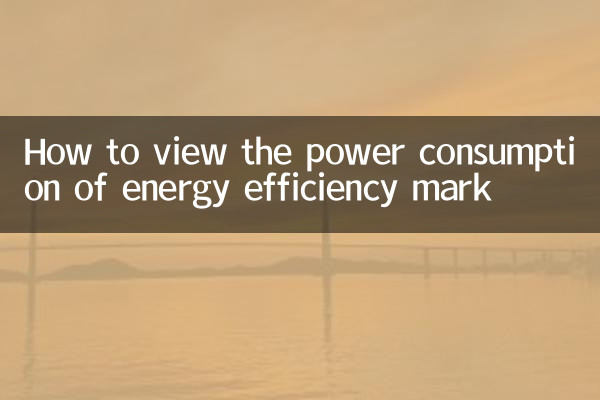How to view the power consumption of energy efficiency mark
With the rise in energy prices and the increase in environmental awareness, consumers are increasingly paying attention to the energy efficiency performance of their products when purchasing home appliances. Energy efficiency marking is an important basis for judging the power consumption of home appliances, but many people are not clear about its specific meaning. This article will introduce in detail how to judge power consumption through energy efficiency markers, and attach popular topics and hot content for the past 10 days to help consumers make smarter choices.
1. Basic structure of energy efficiency marking

Energy efficiency markers are usually divided into five levels, from level 1 to level 5, Level 1 means the highest energy efficiency and Level 5 means the lowest energy efficiency. The logo will also indicate important information such as the annual power consumption and energy efficiency ratio of the product. Here are common energy efficiency marking examples:
| Energy efficiency level | Annual power consumption (kWh) | Energy efficiency ratio (EER) |
|---|---|---|
| Level 1 | ≤200 | ≥3.6 |
| Level 2 | 201-300 | 3.4-3.6 |
| Level 3 | 301-400 | 3.2-3.4 |
| Level 4 | 401-500 | 3.0-3.2 |
| Level 5 | ≥501 | ≤3.0 |
2. How to determine power consumption through energy efficiency marking
1.Check the energy efficiency level: The lower the energy efficiency level (level 1 is the optimal), the higher the energy efficiency of the product and the lower the power consumption.
2.Pay attention to annual power consumption: The energy efficiency marking will clearly indicate the annual power consumption of the product (units in kWh), which is the direct basis for judging the power consumption.
3.Comparative Energy Efficiency Ratio (EER): The energy efficiency ratio is the ratio of cooling capacity to power consumption. The higher the value, the lower the power consumption of the product under the same cooling capacity.
3. Hot topics and hot content in the past 10 days
Here are the hot topics related to energy efficiency markings and home appliance power consumption in the past 10 days:
| Hot Topics | Main content | Popularity index |
|---|---|---|
| Implementation of the new national standard for air conditioning energy efficiency | The new national standard has higher requirements for air conditioning energy efficiency, and the number of level 1 energy efficiency products is reduced | ★★★★★ |
| Comparison of actual power consumption of refrigerator | Multiple media have measured the power consumption of refrigerators of different brands, and the results are significant | ★★★★☆ |
| Interpretation of the energy efficiency marking of washing machine | Experts interpret water consumption and power consumption information in the energy efficiency mark of washing machine | ★★★☆☆ |
| Energy-saving home appliance subsidy policy | Many places introduce energy-saving home appliance subsidies to encourage consumers to purchase energy-efficient products | ★★★★☆ |
| Energy efficiency performance of smart home appliances | Are smart home appliances really more energy-saving? Tested data reveals the truth | ★★★☆☆ |
4. Tips for purchasing energy-efficient home appliances
1.Priority to selecting energy-efficiency products at level 1: Although the price may be higher, long-term use can save more electricity bills.
2.Comparing the annual power consumption of similar products: Even if the energy efficiency level is the same, the power consumption of different brands may vary.
3.Pay attention to the update of energy efficiency markers: With the advancement of technology, energy efficiency standards will continue to improve. Pay attention to check the latest logo when purchasing.
4.Choose from combination of usage habits: For example, northern users may pay more attention to heating energy efficiency when purchasing air conditioners, while southern users may pay more attention to cooling energy efficiency.
5. Summary
Energy efficiency marking is an important tool for judging the electricity consumption of home appliances. Consumers can comprehensively evaluate the energy efficiency performance of products through indicators such as energy efficiency level, annual electricity consumption and energy efficiency ratio. With the popularization of energy-saving and environmental protection concepts, high-efficiency home appliances will become the mainstream choice in the future market. Hope this article helps you better understand energy efficiency marking and make smarter buying decisions.

check the details

check the details